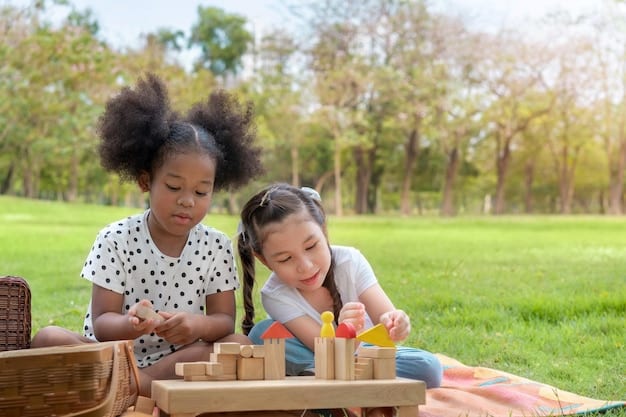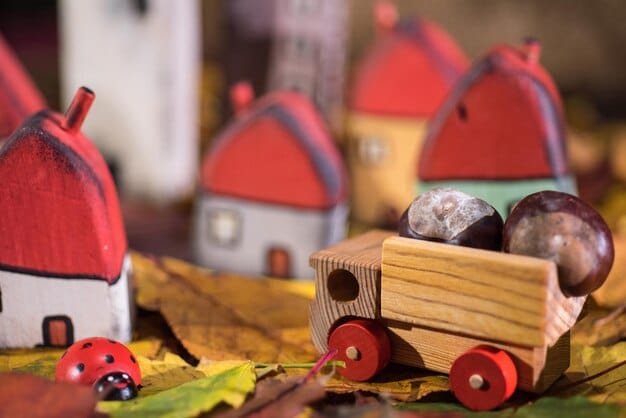The Environmental Impact of Seasonal Toys: Eco-Friendly Choices for US Parents

The Environmental Impact of Seasonal Toys: Sustainable Options for Eco-Conscious Parents in the US explores the detrimental effects of conventional seasonal toys on the environment and provides actionable alternatives for parents seeking eco-friendly choices.
As holiday decorations go up and children eagerly anticipate the seasonal toys that come with each celebration, it’s crucial to consider the environmental footprint of these often short-lived playthings. Let’s examine The Environmental Impact of Seasonal Toys: Sustainable Options for Eco-Conscious Parents in the US, understanding the issues and exploring better choices.
Understanding the Environmental Concerns of Seasonal Toys
Seasonal toys, often associated with holidays and special occasions, bring joy to children but can pose significant environmental challenges. The materials used, the manufacturing processes, and the eventual disposal of these toys contribute to a cycle of waste and pollution.
Let’s explore these environmental impacts and identify the key issues that parents should be aware of.
Materials and Manufacturing
Many seasonal toys are made from plastics, often derived from fossil fuels. The extraction and processing of these materials require significant energy and release greenhouse gases, contributing to climate change. Furthermore, the manufacturing process involves the use of chemicals, some of which can be harmful to both human health and the environment.
Short Lifespan and Disposal
Seasonal toys are often designed to be trendy or disposable, leading to a short lifespan. Once the holiday or season passes, these toys are frequently discarded, ending up in landfills. The accumulation of plastic waste in landfills poses a threat to ecosystems and can take hundreds of years to decompose. Incineration, another common method of disposal, releases harmful pollutants into the air.

Here are some issues that need to be considered:
- Plastic toys take hundreds of years to decompose, contributing to long-term landfill waste.
- The production of plastics leads to greenhouse gas emissions and depletion of fossil fuels.
- Many toys contain harmful chemicals that can leach into the environment and harm wildlife.
- The short lifespan of seasonal toys encourages a culture of disposability, exacerbating waste problems.
By understanding these environmental concerns, parents can make more informed decisions about the toys they purchase for their children, opting for sustainable and eco-friendly alternatives that minimize their environmental impact.
The Impact of Plastics in Seasonal Toys
Plastics are the main building block for a significant majority of seasonal toys in the US. This has significant environmental consequences, because of the extraction, manufacturing, and disposal of plastic items.
Let’s carefully examine the effects of plastics and discover the factors that cause them.
The Dominance of Plastics
Traditional seasonal toys rely heavily on plastics due to their cost-effectiveness, durability, and ease of molding into various shapes and designs. From plastic ornaments and action figures to battery-operated gadgets, plastics make up a substantial portion of the materials used in these toys. The widespread availability and affordability of plastic have made it a popular choice for manufacturers, but at a considerable environmental cost.
Environmental Consequences
The production of plastics contributes significantly to greenhouse gas emissions, as it requires the extraction and refining of fossil fuels like petroleum and natural gas. These emissions contribute to global warming and climate change. Additionally, the disposal of plastic toys poses a major challenge, as plastics can take hundreds of years to decompose, leading to the accumulation of waste in landfills.
Here are some steps that can be taken to manage the environmental burden of using plastics:
- Reducing the production and use of single-use plastics in favor of more sustainable materials.
- Promoting recycling programs and encouraging consumers to recycle plastic toys and packaging.
- Investing in research and development of biodegradable and compostable plastics derived from renewable resources.
- Implementing stricter regulations on plastic waste disposal to prevent pollution of oceans and waterways.
Parents are becoming more aware of the environmental consequences of plastic toys. By understanding the environmental consequences of plastics, parents can make conscious choices when selecting seasonal toys for their children: choosing to reduce the amounts of plastic waste our children generate.
Sustainable Materials for Seasonal Toys
With growing awareness of the environmental impact of traditional seasonal toys, many eco-conscious parents are seeking sustainable alternatives. These materials offer a more environmentally friendly option.
Let’s explore some of the sustainable materials that are gaining popularity in the toy industry.

Wood
Wood is a renewable resource that can be sustainably harvested from responsibly managed forests. Wooden toys are durable, long-lasting, and often biodegradable, making them an excellent alternative to plastic toys. They also have a classic and timeless appeal, providing children with a tactile and sensory-rich play experience.
Bamboo
Bamboo is a fast-growing grass that is highly renewable and requires minimal resources to cultivate. Bamboo toys are lightweight, sturdy, and naturally antibacterial, making them a safe and sustainable choice for children.
Recycled Materials
Using recycled materials is a great way to avoid new waste created when constructing new toys.
Manufacturers are increasingly using recycled materials like recycled plastics, recycled cardboard, and recycled fabric to create seasonal toys. By repurposing existing materials, these toys help reduce waste and conserve resources.
Following are some recommendations for parents looking at sustainable materials:
- Look for toys made from sustainably harvested wood certified by organizations like the Forest Stewardship Council (FSC).
- Consider toys made from bamboo, as it is a rapidly renewable resource that requires minimal pesticides and fertilizers.
- Read product labels and descriptions carefully to identify toys made from recycled materials.
- Support companies that have a strong commitment to eco-friendly manufacturing practices and sustainable sourcing.
Sustainable materials offer a promising path forward for creating seasonal toys that are both fun and environmentally responsible. By choosing toys made from these materials, parents can contribute to a more sustainable future for their children.
Eco-Friendly Brands and Initiatives
With increasing consumer demand for sustainable products, many brands are stepping up to offer eco-friendly seasonal toys and adopt responsible manufacturing practices. These initiatives are helping to reduce the environmental impact of the toy industry.
Let’s examine current popular toy brands and how they contribute toward a positive impact.
Brands Committed to Sustainability
Several toy brands are prioritizing sustainability by using eco-friendly materials, reducing packaging waste, and implementing responsible manufacturing processes. These brands often collaborate with environmental organizations and support initiatives aimed at protecting natural resources and promoting biodiversity.
Certifications and Labels
Eco-friendly toys are often certified by independent organizations that verify their environmental credentials. Look for certifications like the Forest Stewardship Council (FSC) for wood products, the Global Organic Textile Standard (GOTS) for textiles, and the Recycled Content Standard for recycled materials. These certifications provide assurance that the toys meet certain environmental standards.
Here are some important certifications for toy manufacturers:
- Fair Trade certifications ensure that the workers who created the toy were paid ethical wages.
- B Corp certifications show that the company has demonstrated environmental and social goals.
- Greenship certifications show a company has minimized its enviornmental impact.
By supporting eco-friendly brands and initiatives, parents can encourage the toy industry to adopt more sustainable practices. Choosing toys from companies that prioritize environmental responsibility sends a message that consumers value sustainability and are willing to support businesses that align with their values.
Creative DIY Seasonal Toys
One of the most sustainable ways to celebrate seasonal holidays is by making your own toys and decorations using materials you already have at home. DIY seasonal toys offer a fun and creative alternative to store-bought items, reducing waste and encouraging resourcefulness.
Let’s explore some ideas for creating DIY seasonal toys using simple household materials.
Upcycled Materials
Transforming old materials into new toys is a great way to reduce waste and give items a new lease on life. Use fabric scraps to sew plush ornaments, turn cardboard boxes into playhouses or costume pieces, and repurpose glass jars into decorative lanterns or snow globes.
Natural Elements
Bring the beauty of nature into your seasonal celebrations by incorporating natural elements into your DIY toy projects. Gather pinecones, branches, leaves, and stones to create ornaments, wreaths, and nature-inspired decorations. These elements can be sustainably collected from your backyard or local parks.
Following are some unique ways to create DIY toys:
- Create bird feeders from pine cones and peanut butter to make treats for wild animals.
- Make a Christmas village with recycled paper mache from newspapers and paper towels.
- Create snowmen or other various winter holiday decorations out of socks and rice.
DIY seasonal toys offer a unique opportunity for families to bond, get creative, and celebrate the holidays in a sustainable way. By repurposing materials and embracing homemade decorations, you can reduce your environmental impact.
Tips for Eco-Conscious Toy Shopping
Choosing eco-friendly seasonal toys involves more than just selecting sustainable materials. It also requires mindful shopping habits and a commitment to reducing waste. By adopting these practices, parents can make a positive impact on the environment while still providing their children with fun and engaging play experiences.
Parents can reduce their impact on the environment by following these rules.
Prioritize Quality over Quantity
Instead of buying lots of cheap, disposable toys, invest in a few high-quality, durable toys that will last for years. These toys can be passed down to younger siblings or donated to charity when your children outgrow them.
Avoid Over-Packaging
Choose toys that come with minimal packaging or opt for products with recycled or recyclable packaging materials. Try to avoid toys that are heavily wrapped in plastic or other non-recyclable materials.
Reduce the environmental impact of toy shopping:
- Choose to shop local: supporting smaller brands reduces international transport costs.
- Buy in person: buying in person cuts down on cardboard and shipping costs.
- Be prepared: making a detailed list ensures you don’t impulse by toys that will be thrown out later
Eco-conscious toy shopping is a journey, not a destination. By incorporating these tips into your purchasing habits, you can make a positive impact on the environment. Remember, you don’t have to be perfect to make a difference.
| Key Point | Brief Description |
|---|---|
| 🌱 Sustainable Materials | Opt for wood, bamboo, or recycled materials. |
| ♻️ Recycling | Recycle your used toys and decorations and buy recycled. |
| 💡 DIY Options | Have your kids create toys from repurposed resources. |
| 🛍️ Smart Shopping | Buy less: choosing products with minimal packaging reduces impact. |
Frequently Asked Questions
▼
Plastic and synthetic products take a great deal of time to decompose, and they continue to pollute even as they decompose. Purchasing alternate products reduces pollution and waste.
▼
Toys manufactured out of wood, cloth, cotton, and other recycled materials can ensure your child’s toys aren’t harming the natural world. These toys can be just as fun as plastic toys.
▼
Many towns and cities conduct periodic recycling and pick-up programs. Contact your local municipal authorities to see about recycling schedules and guidelines.
▼
Purchasing products online will always have additional shipping costs. Making sure to buy local goods can avoid additional packaging and waste from third-party retailers.
▼
Consumers have more power than they might think. If consumers buy less, brands will be forced to comply with consumer wishes and provide more options for eco-friendly toys.
Conclusion
Choosing sustainability in seasonal toys is a multifaceted approach. By understanding the environmental impact of conventional toys, opting for sustainable materials, supporting eco-friendly brands, and embracing DIY alternatives, parents can make a meaningful difference. Prioritizing quality over quantity and adopting mindful shopping habits further contribute to reducing waste and promoting a healthier planet for future generations.





